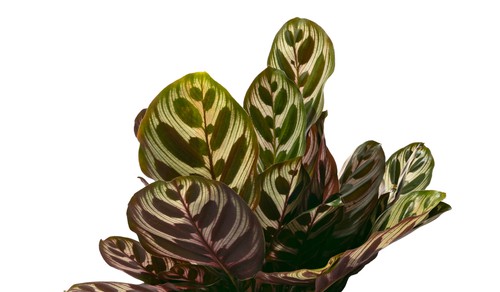Philodendrons are a popular houseplant that can add a touch of greenery to any room. However, one common issue that many philodendron owners face is brown spots on the leaves. These brown spots can be caused by a variety of factors, such as overwatering, pests, or diseases, and can be a sign of an unhealthy plant.
Understanding the causes of brown spots on philodendron leaves is crucial for preventing and treating them. Some common causes include too much direct sunlight, overwatering, or pests such as spider mites or mealybugs.
It’s important to identify the cause of the brown spots to determine the best course of action. In some cases, simply adjusting the plant’s care routine can prevent future brown spots, while in other cases, more aggressive treatment may be necessary.
In this article, we will explore the different reasons why Philodendron leaves develop brown spots, as well as the best practices for preventing and treating them. We will also discuss common pests that can affect philodendrons and how to identify different types of leaf spots.
By the end of this article, readers will have a better understanding of how to care for their philodendron plants and keep them healthy and thriving.
Key Takeaways on Philodendron Leaves Develop Brown Spots
- Brown spots on philodendron leaves can be caused by a variety of factors, including overwatering, pests, and diseases.
- Identifying the cause of brown spots is crucial for preventing and treating them effectively.
- Best practices for philodendron care include providing the right amount of light, water, and nutrients, and taking steps to prevent pests and diseases.
Also don’t miss:
- Pepper Plant Leaves Turning Yellow with Brown Spots
- Peach Tree Leaves Turning Yellow with Brown Spots
- Yellow Leaves and Brown Spots on Peace Lily Plant
Understanding Philodendrons
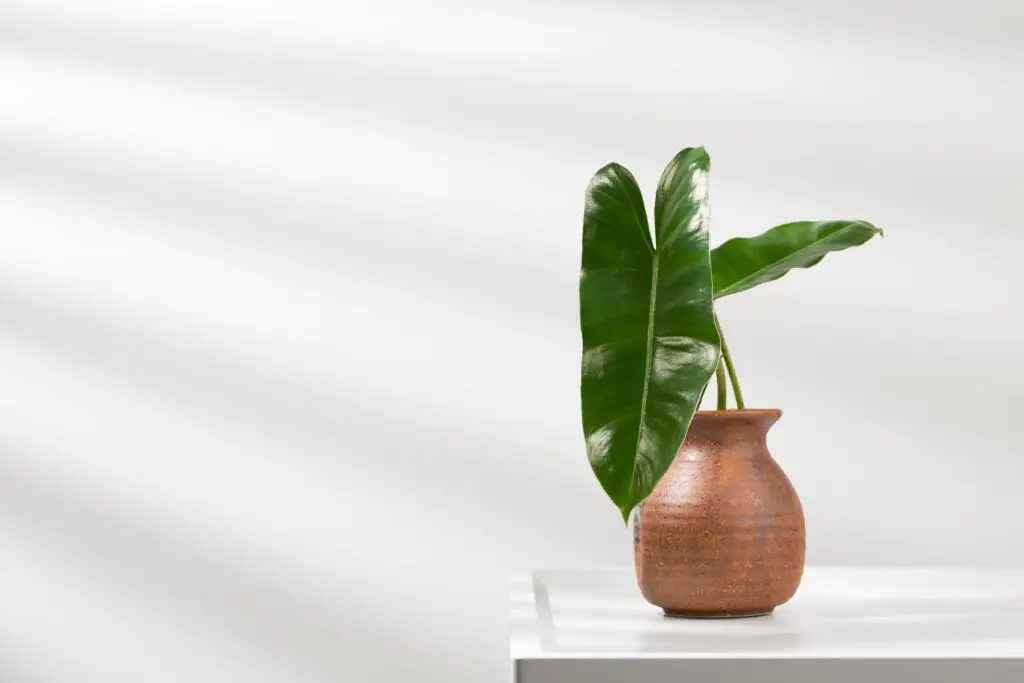
Philodendrons are tropical plants that are known for their beautiful foliage and ease of care, making them a popular choice for houseplant enthusiasts. With over 400 species, philodendrons come in a wide range of shapes and sizes, from small trailing plants to large tree-like specimens.
One of the notable characteristics of philodendrons is their growth rate. These plants can grow rapidly under the right conditions, producing new leaves and extending their vines in a matter of weeks.
This makes them an excellent choice for those who want to add some greenery to their homes without waiting for months or years for the plant to mature.
However, like any other houseplant, philodendrons can also develop issues such as brown spots on their leaves. These spots can be caused by a variety of factors, including nutrient deficiencies, fungal diseases, and natural occurrences.
To keep a philodendron healthy and thriving, it’s important to understand its specific needs and requirements. This includes providing it with the right amount of light, water, and nutrients, as well as monitoring it for any signs of pests or disease.
Identifying Brown Spots on Philodendron Leaves
Philodendrons are popular houseplants that are easy to care for and can add a touch of greenery to any room. However, brown spots on philodendron leaves can be a sign of a problem with the plant.
Identifying the cause of the brown spots is the first step in treating the issue. Here are some common causes of brown spots on philodendron leaves.
Fungal Leaf Spot
Fungal leaf spot is a common problem for philodendrons. It is caused by a fungus that thrives in warm, humid conditions. The fungus appears as dark brown patches on the leaves, which can eventually cause the leaves to turn yellow and fall off.
Fungal leaf spot can be treated with a fungicide. It is important to remove any infected leaves and keep the plant in a well-ventilated area to prevent the spread of the fungus.
Bacterial Leaf Spot
Bacterial leaf spot is another common problem for philodendrons. It is caused by a bacteria that can be spread by water, soil, or insects. The bacteria appears as dark brown lesions on the leaves, which can eventually cause the leaves to turn yellow and fall off.
Bacterial leaf spot can be treated with a copper-based fungicide. It is important to remove any infected leaves and keep the plant in a well-ventilated area to prevent the spread of the bacteria.
Insect Damage
Insects can also cause brown spots on philodendron leaves. Spider mites, mealybugs, and scale insects are common pests that can cause brown spots on the leaves.
These insects feed on the plant’s sap, which can cause the leaves to turn yellow and fall off. Insect damage can be treated with an insecticide. It is important to remove any infected leaves and keep the plant in a well-ventilated area to prevent the spread of the insects.
Causes of Brown Spots
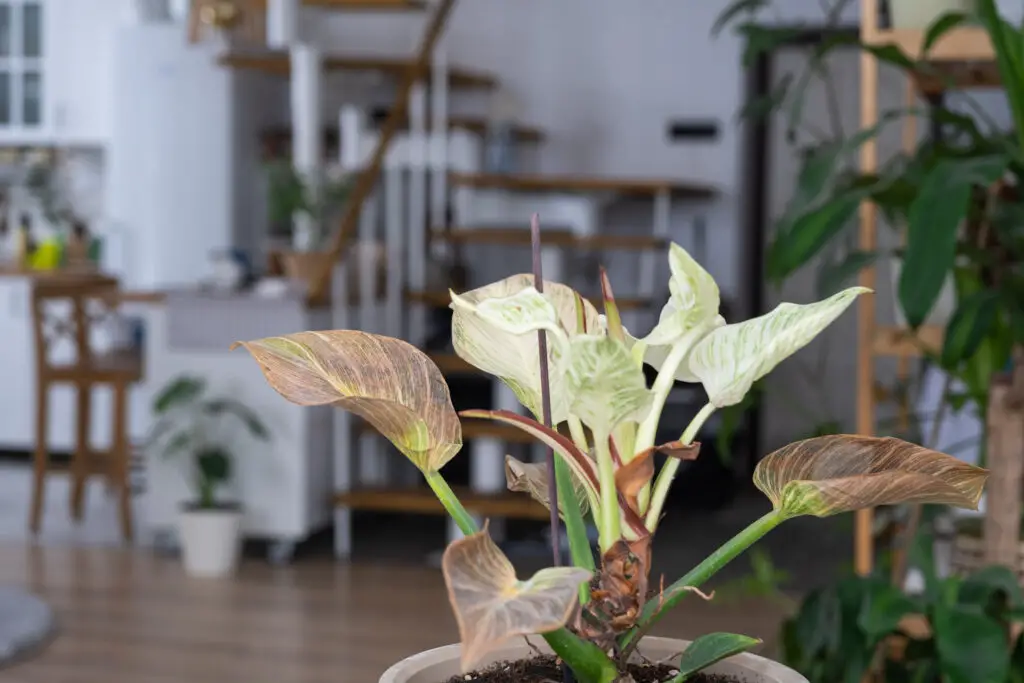
Philodendrons are popular houseplants known for their attractive foliage. However, brown spots on philodendron leaves can be a common problem that can detract from their beauty. There are several reasons why philodendron leaves develop brown spots, and identifying the cause is crucial to prevent further damage.
One common cause of brown spots on philodendron leaves is overwatering. If the soil is too wet, the roots may rot, and the plant may not be able to absorb nutrients properly, leading to brown spots on the leaves. Underwatering can also cause brown spots, as the plant may not be getting enough water to support healthy growth.
Another reason for brown spots on philodendron leaves is exposure to direct sunlight. Philodendrons prefer bright, indirect light, and exposure to direct sunlight can cause the leaves to burn and develop brown spots.
Low humidity levels can also cause brown spots on philodendron leaves, as the plant may not be getting enough moisture from the air.
Pests such as spider mites and mealybugs can also cause brown spots on philodendron leaves. These pests feed on the plant’s sap, leading to brown spots and other damage.
Bacterial and fungal diseases can also cause brown spots on philodendron leaves. These diseases can be spread by overwatering, poor air circulation, and contaminated soil.
Effects of Brown Spots
Brown spots on philodendron leaves can be an indication of an underlying issue that needs to be addressed. These spots can affect the overall health and appearance of the plant, and if left untreated, can lead to serious damage.
One of the most common effects of brown spots is leaf drop. As the spots spread, the leaves may become weakened and eventually fall off. This can result in the plant losing its fullness and becoming less attractive.
Brown spots can also affect the stem of the plant. If the spots are present on the stem, it can lead to rotting and decay, which can ultimately kill the plant. Root rot is another potential effect of brown spots, as it can be caused by overwatering or poor drainage.
In addition to affecting the plant’s structure, brown spots can also impact its color. Leaves may turn yellow or develop brown edges, and yellow spots may appear in addition to the brown spots. Burn-like spots can also appear if the plant is exposed to too much direct sunlight.
Wet brown spots are particularly concerning, as they may indicate a fungal or bacterial infection. These types of infections can spread quickly and cause significant damage to the plant.
Preventing Brown Spots
Preventing brown spots on philodendron leaves is a crucial part of keeping the plant healthy. Here are some best practices to follow to prevent brown spots from appearing on your philodendron leaves:
1. Care and Watering
Philodendrons require a steady supply of water to remain healthy. The soil should always be a little bit moist. If you’re spacing your waterings out too much or watering too lightly, this could be the cause of brown spots. When you water, water thoroughly, not stopping until water flows out of the drainage holes.
2. Fertilizer
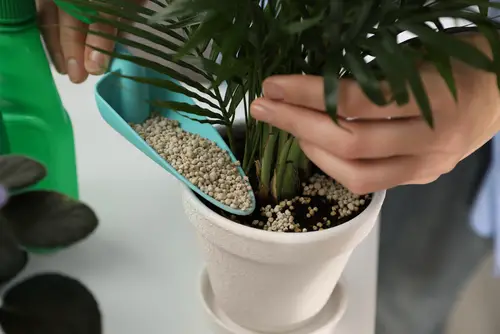
Using organic fertilizer is an excellent option for your philodendron because it is a full source of macro-nutrients that are fully needed for your philodendron to thrive. Slow-releasing pellets are another excellent option for you to use liquid-fertilizer.
3. Light
Philodendrons require bright indirect light. When leaves are exposed to too much sunlight, they can develop brown spots. This is referred to as sunburn, and it is a type of leaf damage that can occur when plants are not properly protected from the sun. Artificial light can be used to supplement natural light if necessary.
4. Air Circulation
Good air circulation is important for philodendrons. If the air is too stagnant, it can lead to fungal growth, which can cause brown spots on the leaves.
5. Growing Medium
The growing medium you use for your philodendron is also important. The best growing medium for philodendrons is a well-draining soil mix. This will ensure that water doesn’t sit at the bottom of the pot, which can cause root rot..
Treating Brown Spots
When it comes to treating brown spots on philodendron leaves, the first step is to identify the underlying cause. This will help you determine the most effective treatment method. In some cases, simply removing the infected leaves may be enough to prevent the spread of the disease.
If the brown spots are caused by a fungal infection, using a fungicide may be necessary. Be sure to follow the manufacturer’s instructions carefully and avoid overuse, as this can damage the plant.
Additionally, it’s important to ensure that the plant is getting enough oxygen and moisture, as these factors can also contribute to fungal growth.
Misting the leaves regularly can help to increase humidity levels and prevent the growth of fungi. Neem oil is another effective treatment for fungal infections, as it has natural antifungal properties. Simply apply a small amount of neem oil to the affected leaves and repeat every few days until the infection clears up.
If the brown spots are caused by a bacterial infection, using a bactericide may be necessary. Again, it’s important to follow the manufacturer’s instructions carefully and avoid overuse. Additionally, ensuring that the plant is healthy and well-nourished can help to prevent bacterial infections.
Fertilizing the plant regularly can help to provide the necessary nutrients and promote healthy growth. However, be sure to use a fertilizer that is specifically designed for philodendrons and avoid over-fertilization, as this can lead to nutrient burn..
Common Pests in Philodendrons
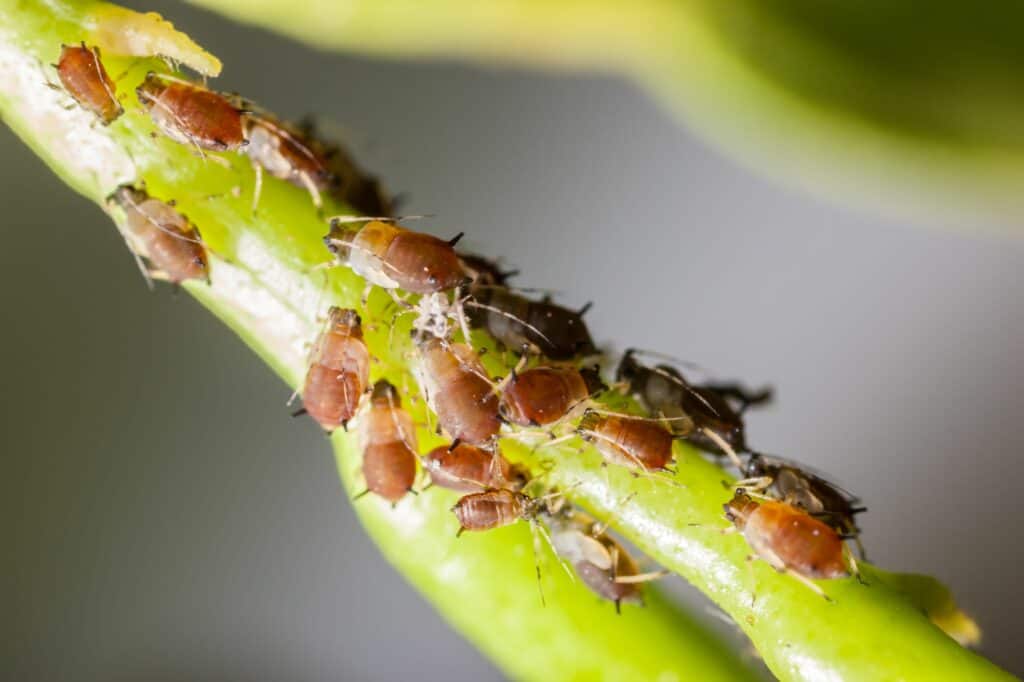
Philodendrons are susceptible to various pests that can cause brown spots on their leaves. These pests can cause significant damage to the plant if not controlled. Here are some common pests that can infest philodendrons:
1. Spider Mites
Spider mites are tiny pests that can be difficult to see with the naked eye. They can cause significant damage to the plant by sucking the sap from the leaves, causing them to turn yellow and develop brown spots.
Spider mites thrive in dry and dusty conditions, so it’s essential to keep the plant’s foliage clean and moist. Horticultural oils and insecticidal soaps are effective in controlling spider mites.
2. Mealybugs
Mealybugs are small, white, and fluffy insects that can infest philodendrons. They feed on the plant’s sap, causing the leaves to turn yellow and develop brown spots. Mealybugs are difficult to control, but insecticidal soaps and horticultural oils can be used to kill them.
3. Aphids
Aphids are tiny, pear-shaped insects that can infest philodendrons. They suck the sap from the leaves, causing them to turn yellow and develop brown spots. Aphids can be controlled by spraying the plant with a strong jet of water or using insecticidal soaps.
4. Scale Insects
Scale insects are small, oval-shaped insects that can infest philodendrons. They feed on the plant’s sap, causing the leaves to turn yellow and develop brown spots. Scale insects can be controlled by using insecticidal soaps or horticultural oils.
Understanding Different Types of Leaf Spots
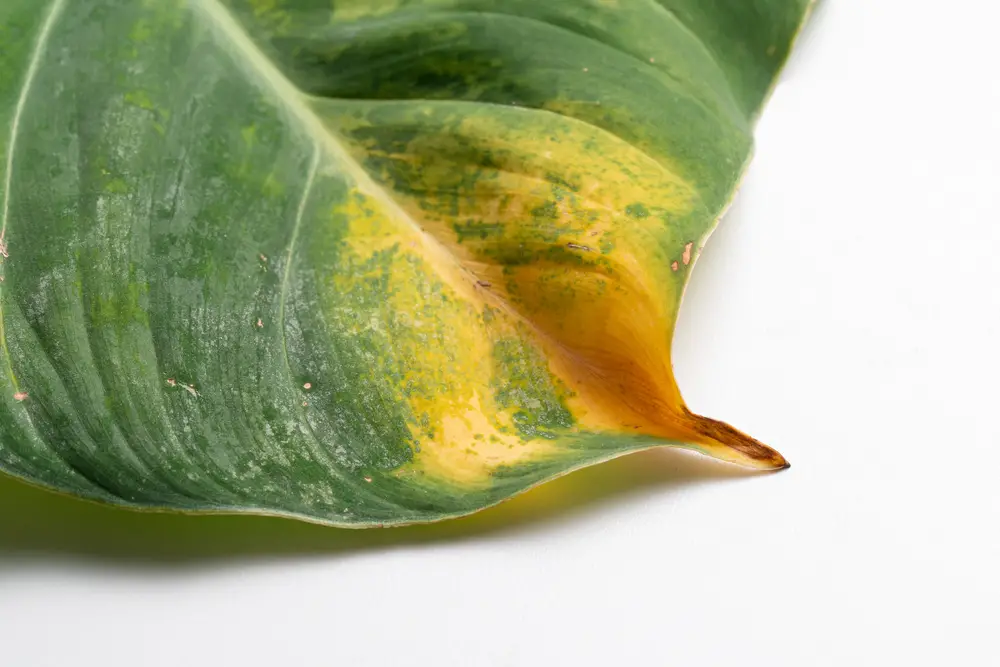
Philodendrons are prone to developing brown spots on their leaves, which can be caused by various factors. Understanding the different types of leaf spots can help you identify the underlying problem and take appropriate measures to fix it.
Bacterial Leaf Spot
Bacterial leaf spot is a common disease that affects philodendrons. It is caused by the bacteria Xanthomonas campestris and can cause small, water-soaked lesions on the leaves. These lesions can turn brown and become dry over time. The affected leaves may eventually fall off, leading to defoliation.
Fungal Leaf Spot Disease
Fungal leaf spot disease is another common problem that can cause brown spots on philodendron leaves. It is caused by various fungi, including Cercospora, Colletotrichum, and Phyllosticta.
The symptoms of fungal leaf spot disease include small, circular or irregularly shaped spots on the leaves, which may have a yellow halo around them. The spots can merge together and form larger lesions, which can cause the affected leaves to wilt and die.
Dry Spots
Dry spots can also cause brown spots on philodendron leaves. These spots are usually caused by injury to the leaves, such as damage from chemicals, heat, or cold.
The affected areas may turn brown and become dry, and the leaves may curl up or drop off. Dry spots can also be caused by fungal infections, which can lead to the development of small, dry, brown spots on the leaves.
Nectaries
Some philodendron species have brown spots that are naturally occurring and not a sign of disease or injury. These spots are called nectaries and are found on the leaf stems or sometimes on the leaves themselves.
Nectaries play an important role in healthy philodendrons by providing sap to attract insects that help pollinate the plant.
Best Practices for Philodendron Care
Philodendrons are tropical houseplants that are easy to care for, making them a popular choice for plant enthusiasts. However, they can develop brown spots on their leaves due to various reasons. To prevent this, it is important to follow some best practices for philodendron care.
1. Watering
One of the most important factors in philodendron care is proper watering. Overwatering can lead to root rot and underwatering can cause the plant to dry out. The soil should always be slightly moist but never waterlogged.
It is recommended to water thoroughly, until water flows out of the drainage holes, and then allow the soil to dry out slightly before watering again.
2. Humidity and Temperature
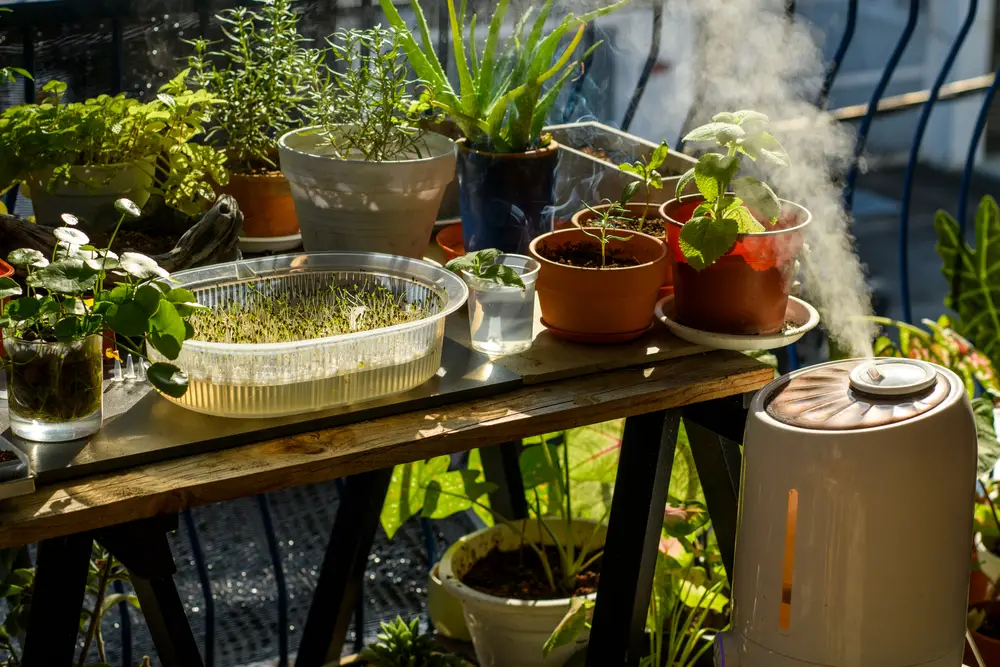
Philodendrons thrive in a tropical environment with high humidity and warm temperatures. Low humidity can cause the leaves to dry out and turn brown, while cold temperatures can cause cold injuries and brown edges.
To increase humidity, mist the leaves regularly or place the plant on a tray of pebbles and water. Keep the plant away from cold drafts and direct sunlight, which can cause burn-like spots.
3. Air Circulation
Good air circulation is important for philodendron care as it helps prevent fungal and bacterial diseases. Make sure the plant is not overcrowded and has enough space between other plants.
4. Fertilization
Philodendrons are not heavy feeders, but they do need some fertilizer to maintain their growth rate. Use a balanced fertilizer once a month during the growing season.
5. Treatment and Prevention
If your philodendron develops brown spots on its leaves, it may be due to a fungal or bacterial leaf spot disease. Isolate the infected plant and remove affected leaves. Use a fungicide or bactericide to treat the plant, following the instructions carefully.
To prevent pest infestations, inspect the plant regularly and use insecticidal soaps or horticultural oils to control scale insects, mealybugs, aphids, and spider mites.
6. Potting Soil and Drainage

Philodendrons prefer a well-draining growing medium that is rich in oxygen. Use a topsoil-based potting mix that allows excess water to drain away. Make sure the pot has drainage holes and that excess water does not accumulate at the bottom of the pot, which can lead to root rot.
Frequently Asked Questions
How do you treat leaf spot disease in philodendron?
Leaf spot disease in philodendron can be treated in a few ways. Firstly, remove any affected leaves and dispose of them properly. Next, ensure that the plant is not overwatered and that it has good air circulation.
If the condition persists, use a fungicide that is safe for philodendron, following the instructions on the label.
What are the burn spots on my philodendron?
Burn spots on philodendron leaves are often caused by excessive exposure to direct sunlight or from using water that is too hot when watering the plant. Move the plant to a shadier location and use room temperature water to avoid further damage.
Why does my philodendron have spots on the leaves?
Philodendrons can develop spots on their leaves due to a variety of reasons, including fungal or bacterial infections, pest infestations, or environmental factors such as overwatering or exposure to direct sunlight. Identifying the cause of the spots is important in determining the appropriate treatment.
Philodendron fungal leaf spot disease
Philodendron fungal leaf spot disease can be treated by removing the affected leaves and improving the plant’s growing conditions. Ensure that the plant is not overwatered and has good air circulation. If the condition persists, use a fungicide that is safe for philodendron, following the instructions on the label.
How do you treat brown spots on philodendrons?
Brown spots on philodendron leaves can be treated by removing the affected leaves and improving the plant’s growing conditions. Ensure that the plant is not overwatered and has good air circulation. If the condition persists, use a fungicide that is safe for philodendron, following the instructions on the label.
Philodendron leaf spot disease treatment
Philodendron leaf spot disease can be treated by removing the affected leaves and improving the plant’s growing conditions. Ensure that the plant is not overwatered and has good air circulation. If the condition persists, use a fungicide that is safe for philodendron, following the instructions on the label.

Hey, I’m Lisa and I’ve been an avid gardener for over 30 years. I love writing, talking and living in the garden! Feel free to connect with me on my socials below

